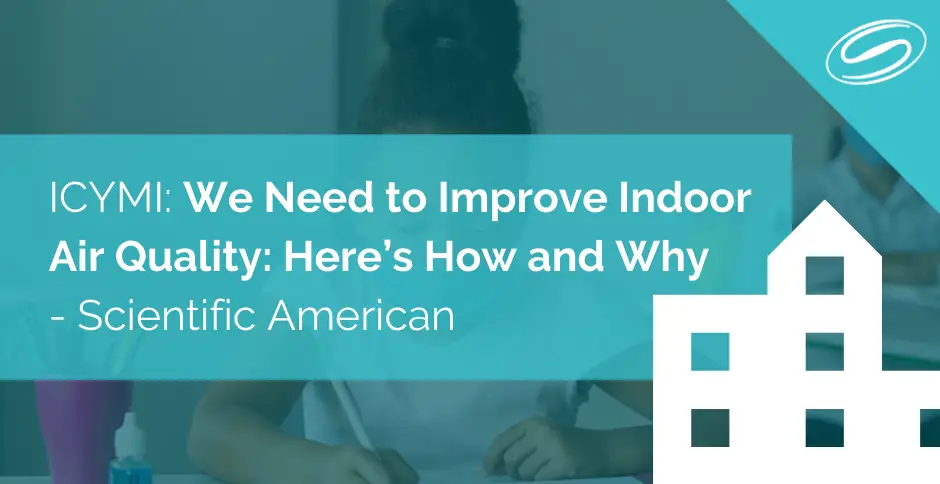
More Than Air Purification: Your Guide to Air Sterilization
Breathing in fresh, clean air is like a secret potion for our well-being and joyous existence.
High-Efficiency Particulate Air (HEPA) filters have long been the standard for air purification methods. With 99.97% efficacy in removing airborne particles, it’s no wonder consumers and industries alike see HEPA filters as safe and reliable. However, the drawbacks of this long-standing technology are overlooked, or the technology is determined to be “good enough” when it comes to indoor air quality.
HEPA filters have an interesting place in history; their inception dates back to the 1940s. Invented to filter radioactive particles from the air when engineers were working on the Manhattan Project, HEPA air filtration was relatively primitive back then — remaining as a classified technology until the end of WWII. Following the war, HEPA air filters were available for widespread use in commercial settings and in the homes of consumers. Since then, these devices have gradually developed to filter the air in more critical applications such as healthcare, aerospace, educational settings, and more.
In today’s world, however, an increasingly common application for HEPA filters is temporary tent structures. We use these types of structures in a variety of industries such as healthcare, education, as well as in military settings, to name a few. As COVID-19 remains omnipresent in our daily lives, many industries have opted for alternative spaces that can offer more air flow and isolate potential infections within a designated space. For this reason, we often equip tent shelters with air purification technology such as HEPA air filtration, as a precautionary measure against compromised air quality.
HEPA filters are composed of thick, matted fibers designed to capture particles larger than 0.3 microns like mold spores, bacteria, and dust. This is especially beneficial to those who have allergies, difficulties breathing, or need added protection when breathing air in certain environments with a high potential for air contamination. However, HEPA filters are not without their disadvantages.
HEPA filters will inevitably require maintenance at one point or another. Sure, there are filters you can either replace when needed or simply wash — but washable filters eventually become less effective the more they need to be cleaned, while replaceable filters accumulate higher costs. The act of simply changing the filter can come with some very unintended consequences — like pathogens and mold escaping the filter and being released right back into the air. These filters are essentially hazardous waste, and depending on what setting you’re in, it’s often quite difficult to dispose of properly.
While HEPA air filtration has improved in its ability to conform to modern-day needs, the technology continues to fall short when it comes to energy efficiency. Many HEPA air filter companies have touted the dubious claim that their devices become more efficient the dirtier the filters become.
Sure, logically, it makes sense that the denser the filters become the more particles can be trapped — but this doesn’t account for the adverse effect on airflow or how mold and bacteria can thrive in environments with high humidity such as temporary tent structures. Therefore, industries that use HEPA opt for integrations or add-ons to supplement a HEPA filter’s performance.
HEPA filters can integrate with several supplemental disinfection methods. Although, many of these technologies are subject to limited research and confusion in terms of efficacy.
For example, UV lights can disinfect surfaces and eradicate bacteria but are not effective against airborne particles. In addition, it’s difficult to assess the efficacy of light-based disinfection technology since the density of the fibers in the filter itself allows very little light penetration.
Air ionization is another supplemental technology that can be integrated into HEPA. Air ionizers work by using positively and negatively charged ions to cluster large and small particles together, making it easier for these particles to be filtered out of the air by a HEPA filter. Conceptually, this technology filters out particles of various sizes, especially smaller particles such as viruses that HEPA filters alone cannot capture. But like UV light-based air purification, air ionizers are not exempt from well-deserved scrutiny — with many studies showing an overall lack of consistency in terms of effectiveness, as well as it’s potential to release harmful ozone into the air.
And since this technology is fairly new, there’s essentially no research on its long-term effects on humans.
These are all worthwhile considerations for attempting to provide optimal air quality in designated isolation spaces such as temporary tent structures, but each one is marred by drawbacks.
This is why SteriSpace is here to change the notion that drawbacks are unavoidable for air purification.
When it comes to treating airborne contaminants, SteriSpace has no equal.
SteriSpace’s unique, heat-compression technology can easily integrate into an existing HVAC system, HEPA air filter, or as a standalone unit.
Also, did we mention that SteriSpace is the only true air sterilization technology on the market?
SteriSpace achieves this by destroying 99.9999% of airborne contaminants similar to SARS-like viruses, environmental pollutants, mold and bacteria, certain Anthrax simulants, as well as VOCs and toxic fumes when combined with a chemical catalyst.
Unlike other air filtration technology, SteriSpace uniformly treats the air and configures to maintain positive or negative pressure based on the surrounding environment’s needs. SteriSpace allows for recirculation of sterilized air while using thermal and acoustic insulation, saving on energy and heat costs in the winter – which is especially helpful for temporary tent structures since they lack insulation. SteriSpace is advancing the standards for air quality in a variety of settings, free of drawbacks and equipped to handle whatever life throws at it.
Schedule a call with one of our air quality consultants to learn more about how SteriSpace can be a game-changer in maintaining optimal air quality in your industry!

Breathing in fresh, clean air is like a secret potion for our well-being and joyous existence.

We now know how important ventilation is to limiting the transmission of airborne diseases and maintaining healthy learning environments.

Did you miss this? In a recent article by Scientific American, they discuss the need for buildings to invest in ventilation and filtration upgrades to improve air quality and decrease COVID transmission.